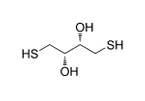2,3-dihydroxy-1,4-dithiolbutane (DTT)

Name: 2,3-dihydroxy-1,4-dithiolbutane(DTT);
MW:154.25; CAS #: 3483-12-3;
Solubility: water, ethanol, chloroform, ethyl acetate, ether
Storage: Upon receipt store at room temperature in sealed container to prevent oxidation.
Dithiothreitol is the trans isomer of the compound 2,3-dihydroxy-1,4-dithiolbutane. DTT, also known as Cleland’s Reagent, is a cell-permeable, strong but mild reducing agent, with a low redox potential of -0.33 V at pH 7 (optimal pH range 7.1 to 8.0). This allows it to reduce practically all accessible biological disulfides, as well as to protect free thiols from oxidation.
The reduction of disulfide-containing compounds by dithiothreitol is a two-step reaction. First, DTT forms a mixed disulfide with the target molecule in a reversible reaction, reducing one sulfur to the corresponding sulfhydryl. In the second step, intramolecular cyclization of DTT leads to an energetically favored six-membered cyclic disulfide. This drives the reaction to completion, reducing the second sulfur of the original disulfide bond. Consequently, DTT is required in much lower concentrations compared to monothiol reducing agents (e.g. glutathione or 2-mercaptoethanol). The latter are usually required in extreme excess to completely reduce target compounds.

Figure 1. Reduction of organic disulfide bonds with DTT.
Application
• Most commonly, Dithiothreitol is used to reduce disulfide bonds in peptides and proteins. However, as with all reductants, DTT can only reduce disulfides if they are accessible.
• At low concentrations, DTT can be used to stabilize proteins with free thiol groups. Conversely, high concentrations of DTT are utilized in order to denature proteins, e.g. before performing an SDS-PAGE.
Recommended concentrations for DTT Usage
| Concentrations to use | Application |
| 1-10 mM | Maintain reduced proteins in solution |
| 50-100 mM | Complete reduction for electrophoresis |
General protocol to reducing Cysteines in a protein or peptide solution
• Make a 1M dithiothreitol DTT stock solution in water, best to make fresh (try not to inhale the DTT).
• Add DTT to the protein or peptide solution (which is in a buffer) to a final concentration of 1mM to 10mM DTT. Incubate for 10 min. to 30 min. The reduction may work slightly better if incubating at higher temperature, such as at 37 degrees C or at 56 degrees C. However, room temperature or ice should work too.
Reducing proteins or peptides in solution prior to alkylation
• Reduce the protein as above.
• Incubate the disulfide-reduced protein or peptide samples at an NEM molarity of at least 3-fold higher than that used for DTT. Incubate for 30 min. to 1 h.
• Dialyze away the DTT or NEM if desired.
Aladdinsci: https://www.aladdinsci.com
